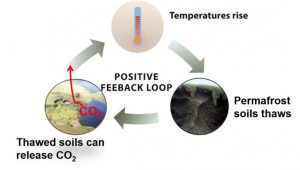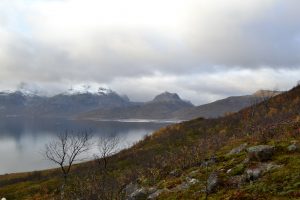The increase in area affected by Arctic wildfires and thawing permafrost is the result of climate change. The issues explored in this website are connected by the undeniable fact that Anthropogenic climate change is causing rapid alterations to the Arctic landscape. Melting permafrost has caused Arctic infrastructure to crumble and increased the accessibility of flammable material in the Arctic. Through this website we will also explore the irony of how oil extraction in the Arctic has become threatened by the very permafrost thaw the oil industry has caused.
How do Arctic oil, wildfires, and shipping connect?

Key Terms:
- Permafrost as defined by the international permafrost association is ground (soil or rock) that remains at, or below 0 C for at least 2 years.
- Peatland is a land area that is primarily made up of peat which is an accumulation of partially decayed vegetation or organic matter.
- Anthropogenic is human impact on the environment
- CO2 and Methane are two of the most potent drivers of climate change and global warming
- Alaskan North Slope is the region of northern Alaska that sits inside the Arctic Circle and along the Arctic Ocean.
- Oil Spills are the release of liquid petroleum into an environment, especially a marine ecosystem, due to human activity – which constitutes a form of pollution
Background
- When frozen, permafrost can be compared to concrete. It is almost impenetrable and a solid building surface. However, once permafrost melts it creates a loose slurry that can lead to road and building collapse.
- Permafrost is also extremely rich in hydrocarbons, as the cold slows microbial breakdown allowing a build up of organic matter. This fuel can then either be rapidly broken down by microbes during thaws, or may even catch on fire and smolder underground for years

- In either case, more CO2 and methane is released into the atmosphere. This further warms the climate and exacerbates this vicious cycle.
Questions:
- How is climate change affecting Arctic ecosystems and the people who live and work there?
- How has a changing climate made Arctic wildfires more dangerous and common?
- How has melting permafrost changed carbon gas dynamics in the Arctic?
- Given the extreme challenges created by operating on thawing permafrost, can oil and gas extraction continue in the Arctic?
Navigation:
Please consider taking the time to review our individual policy recommendations for Arctic wildland fire and oil spill response under the Issues and Policy Ideas tab.
Hajna Nagy: Oil Spill Prevention, Preparedness, & Progress
Griffin Marshall: North Slope Oil Production
Sarah Evans: Arctic Wildland Fires
Jack Burnett: Arctic Peatland Wildfires
